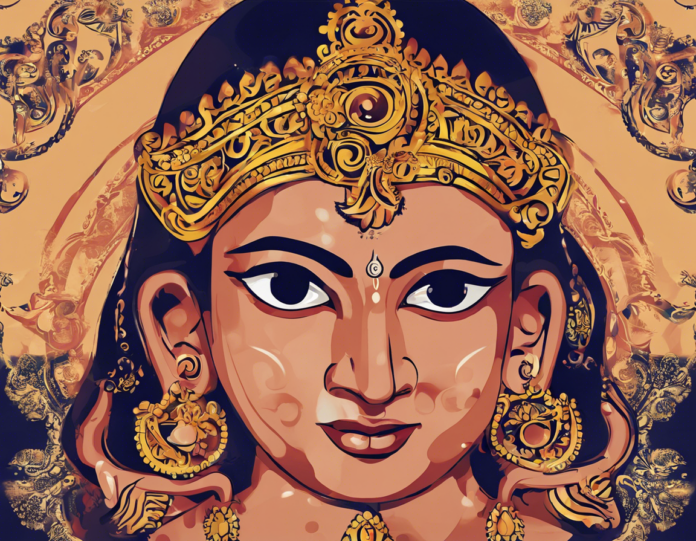The auspicious occasion of Shubho Mahalaya marks the beginning of Devi Paksha and the end of Pitru Paksha, ushering in the festive spirit of Durga Puja. This significant day holds immense cultural and religious significance for devotees of Goddess Durga, particularly in the Indian states of West Bengal, Assam, Odisha, and Bihar. As the earth resonates with spiritual fervor and divine energy, let us delve into the customs, rituals, and legends associated with Shubho Mahalaya.
Understanding the Significance of Shubho Mahalaya
Shubho Mahalaya symbolizes the invocation of the Goddess Durga and the initiation of the countdown to Durga Puja, a grand festival celebrated with unparalleled zeal and enthusiasm in many parts of India. According to Hindu mythology, it is believed that Goddess Durga begins her journey from Kailash to her maternal home on earth during this period. The day is also considered auspicious for performing tarpan (offering to ancestors) by devotees to seek blessings for their departed loved ones.
Mythological Legends and Stories
1. Mahishasura Mardini
One of the most popular stories associated with Shubho Mahalaya is the tale of Mahishasura Mardini – the slayer of the demon Mahishasura by Goddess Durga. It is believed that the Goddess, riding a lion, waged a fierce battle against the demon for nine days and nights, ultimately vanquishing him on the tenth day, known as Vijayadashami.
2. The Creation of Goddess Durga
According to another legend, the powerful trinity of Brahma, Vishnu, and Shiva combined their energies to create Goddess Durga, bestowing her with unique powers and weapons to combat the forces of evil and restore cosmic balance.
Rituals and Customs Observed on Shubho Mahalaya
1. Pre-dawn Invocations
Devotees wake up before dawn to chant hymns and prayers from the scripture Devi Mahatmya, seeking the blessings of Goddess Durga and invoking her presence on earth.
2. Tarpan and Ancestral Offerings
Families perform tarpan rituals by offering water, sesame seeds, and barley to their ancestors, seeking their blessings and peace for their departed souls.
3. Painting of Goddess Durga’s Eyes
In a traditional custom known as “Chokkhu Daan,” artists and priests paint the eyes of the idol of Goddess Durga, infusing it with life and spiritual energy.
4. Airing of Mahalaya Radio Broadcast
Listening to the enchanting recitation of “Mahishasura Mardini” by the late Birendra Krishna Bhadra on All India Radio has become a beloved tradition for many, evoking a sense of nostalgia and devotion.
The Cultural Extravaganza of Mahalaya
Shubho Mahalaya is not just a religious event but also a cultural extravaganza that resonates with music, dance, and artistic expressions. In West Bengal, elaborate puja pandals, dazzling illuminations, and vibrant cultural programs showcase the rich heritage and creativity of the Bengali community. Artisans and craftsmen work tirelessly to create magnificent idols of Goddess Durga, depicting her in various forms and postures.
Embracing Modernity with Virtual Celebrations
In the age of technology and digital connectivity, the celebration of Shubho Mahalaya has transcended physical boundaries, with virtual darshans, online pujas, and live streaming of cultural events gaining popularity. Virtual platforms provide devotees across the globe the opportunity to participate in the festivities and witness the divine grace of Goddess Durga.
FAQs about Shubho Mahalaya
1. What is the significance of listening to “Mahishasura Mardini” on Mahalaya?
Listening to “Mahishasura Mardini” on Mahalaya is believed to invoke the blessings of Goddess Durga and drive away negativity and evil forces from one’s life.
2. Can non-Bengalis participate in the celebrations of Shubho Mahalaya?
Absolutely! Shubho Mahalaya is a festival that transcends cultural boundaries, and people from all walks of life are welcome to join in the festivities and seek the blessings of Goddess Durga.
3. How long does the celebration of Shubho Mahalaya last?
Shubho Mahalaya marks the beginning of a ten-day festival that culminates in Durga Puja, with each day holding its unique rituals and significance.
4. Are there any specific food items associated with Shubho Mahalaya?
While there are no strict dietary restrictions, many people choose to observe a vegetarian diet during this period as a mark of respect for the Goddess.
5. Can I perform tarpan rituals at home on Shubho Mahalaya?
Yes, you can perform simple tarpan rituals at home by offering water and prayers to your ancestors, seeking their blessings and peace.
As we immerse ourselves in the divine aura of Shubho Mahalaya, let us embrace the spirit of renewal, gratitude, and devotion that this auspicious day brings. May the blessings of Goddess Durga illuminate our lives and lead us to victory over adversities, both internal and external. Shubho Mahalaya!





